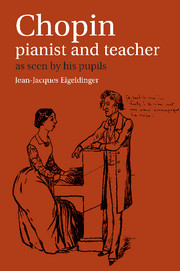Book contents
- Frontmatter
- Contents
- List of illustrations
- Acknowledgements
- Explanation of references
- Editor's note
- Abbreviations
- Introduction
- Part I Technique and style
- Part 2 Interpretation of Chopin's works
- Notes
- List of Chopin's pupils whose recollections are quoted in this book
- Appendix I Translated transcript of Chopin's ‘Sketch for a method’ (Projet de méthode)
- Appendix II Annotated scores belonging to pupils and associates of Chopin
- Appendix III Fingerings and annotations in the scores of pupils and associates
- Appendix IV Chopin's playing described by his contemporaries
- Bibliography
- Index of persons
- Index of musical works
Part 2 - Interpretation of Chopin's works
Published online by Cambridge University Press: 05 June 2014
- Frontmatter
- Contents
- List of illustrations
- Acknowledgements
- Explanation of references
- Editor's note
- Abbreviations
- Introduction
- Part I Technique and style
- Part 2 Interpretation of Chopin's works
- Notes
- List of Chopin's pupils whose recollections are quoted in this book
- Appendix I Translated transcript of Chopin's ‘Sketch for a method’ (Projet de méthode)
- Appendix II Annotated scores belonging to pupils and associates of Chopin
- Appendix III Fingerings and annotations in the scores of pupils and associates
- Appendix IV Chopin's playing described by his contemporaries
- Bibliography
- Index of persons
- Index of musical works
Summary
Chopin's compositions have opened a new era in the piano's history. But they run the risk of being misunderstood if one has not known the master's way of playing, his intentions and his conception of the instrument – since their result on paper is quite different from that of the sound world in which they really live.
Lenz, 1872Any deliberate misreading of his compositions [Chopin] resented sharply.
HalléAndante spianato op. 22, G major
[…] But of all he played when I heard him, I best remember the Andante Spianato […] Physical weakness was not, however, the cause of his tenderly-subdued style of playing. This was his own, and inseparable from his conception of pianoforte touch; it was incapable of modification from any influence whatever. His fortissimo was the full pure tone without noise, a harsh inelastic note being to him painful. His nuances were modifications of that tone, decreasing to the faintest yet always distinct pianissimo. His singing legatissimo touch was marvellous. The wide extended arpeggios in the bass were transfused by touch and pedal into their corresponding sustained chords, and swelled or diminished like waves in an ocean of sound. He kept his elbows close to his sides, and played only with finger-touch, no weight from the arms. He used a simple, natural position of the hands as conditioned by scale- and chord-playing, adopting the easiest fingering, although it might be against the rules, that came to him.
- Type
- Chapter
- Information
- Chopin: Pianist and TeacherAs Seen by his Pupils, pp. 65 - 89Publisher: Cambridge University PressPrint publication year: 1987



